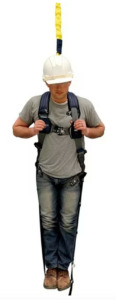FALL PROTECTION: SUSPENSION TRAUMA
The majority of employees are aware of fall hazards in their work environment. They also have knowledge in fall protection strategies, required equipment, and inspection protocols. However, they are often unaware of orthostatic intolerance and suspension trauma.
 Ortho Static Intolerance
Ortho Static Intolerance
Orthostatic intolerance is “the development of symptoms such as light-headedness, heart palpitations, poor concentration, fatigue, nausea, headache, sweating, weakness, and occasional fainting while standing upright.” It results from blood accumulating in the leg veins. This can be caused by lack of movement or the force of gravity.
Orthostatic intolerance requires the legs to remain relaxed, straight, tight, and below head level. Leg muscles contract while walking or shifting positions. This causes leg muscles to press against the veins in the legs pumping blood back to the heart. This is why orthostatic intolerance is uncommon during daily activities.
Circulation is reduced when blood accumulates in the legs. The body responds by speeding up the heart rate. This maintains blood flow to the brain. If blood flow is significantly reduced, speeding up the heart rate is not effective. In response, the body will abruptly slow the heart rate which reduces blood flow. Reduced blood flow to the brain can cause fainting or loss of consciousness.
Suspension Trauma
Death resulting from orthostatic intolerance is called suspension trauma. Consider a worker hanging in a body harness. The harness’s straps put pressure on the leg veins. This compresses the veins causing reduced blood flow to the heart. Without leg muscle contraction, blood flow to the heart will slow. This causes the worker to lose consciousness. Prolonged suspension can result in serious physical injury or even death. Research shows that suspension in a body harness can result in unconsciousness, and possibly death within 30 minutes.
Preventing Suspension Trauma
A worker can slow the onset of suspension trauma by pumping the legs while suspended in a harness. This activates the leg muscles which help pump blood back to the heart.
Suspension trauma straps are also helpful. They connect directly to the harness. The straps allow the worker to remain upright. This activates the leg muscles, reduces venous pooling, and restores blood blow to the heart.
Fall Rescue
Rescuing a worker quickly can prevent suspension trauma. The Occupational Safety and Health Administration (OSHA) requires that employers provide for “prompt rescue of employees in the event of a fall.” Prompt rescue may require an in-house rescue team or first responders. Rescuers utilize equipment such as ladders, ropes, and aerial lifts to rescue suspended workers.
Rescue personnel must be careful when handling an unconscious worker. The lethal surge of blood returning to heart is called reflow syndrome. Reflow syndrome occurs when a worker is removed from the harness and placed flat on their back. Rescuers must keep the worker’s upper torso upright at least 30-40 degrees. The worker can be positioned flat on their back over a 45-minute period.
Conclusion
It is important to plan for fall related emergencies. Evaluate activities that require fall protection equipment at your facility as well as your rescue plan. Make sure employees are knowledgeable of the dangers associated with suspension trauma. Never allow workers using fall arrest equipment to work alone and make sure they know what to do in the event of a fall. Remember, safety doesn’t have to be difficult, simple steps, such as educating workers on suspension trauma can prevent serious injuries and save lives.
Related Links
- Fall Protection Calculations
- Fall Protection Equipment Inspections
- Course Catalog – Safety Made Simple
References
- Raynovich, William. “Dangerous Suspension: Understanding Suspension Syndrome &Prehospital Treatment for those at Risk.” Journal of Emergency Medical Services 31 July 2009: 1-10. Print.
- Weems, Bill and Bishop, Phil “Will Your Safety Harness Kill You.” Occupational Health and Safety (OHS) March 2003: Print.
- United States Department of Labor. (2011). Safety and Health Information Bulletin (SHIB-03-24-2011). Suspension Trauma/Orthostatic Intolerance. Occupational Health and Safety Administration.
Joe Mlynek is a partner and subject matter expert at Safety Made Simple, LLC. He has over 25 years of experience in safety at the corporate level and as a consultant. He is a Certified Safety Professional (CSP) and Occupational Safety and Health Technician (OHST). Joe can be reached at joe.mlynek@safetymadesimple.com.
